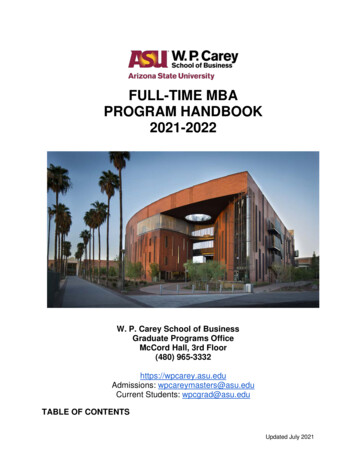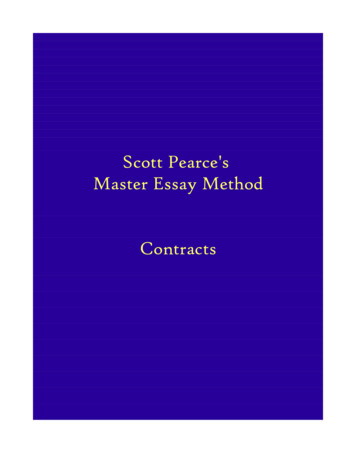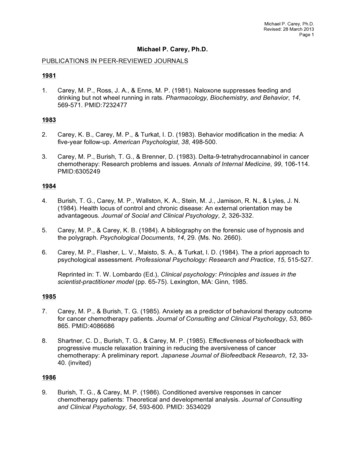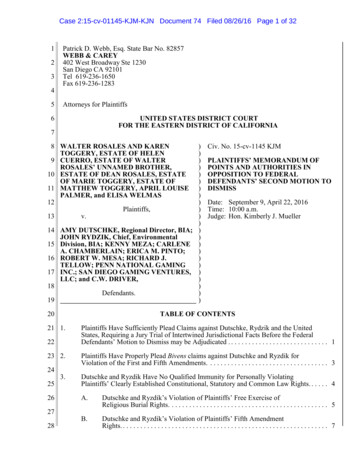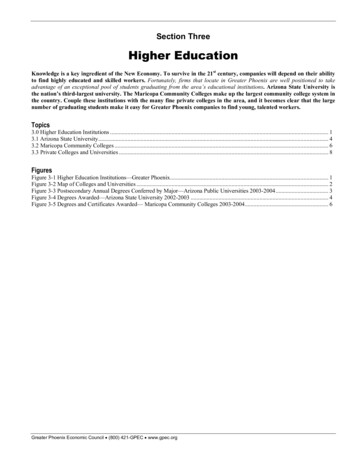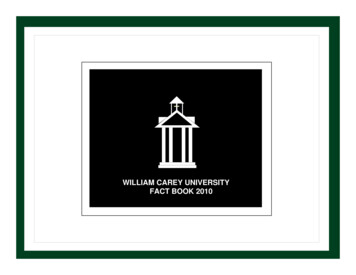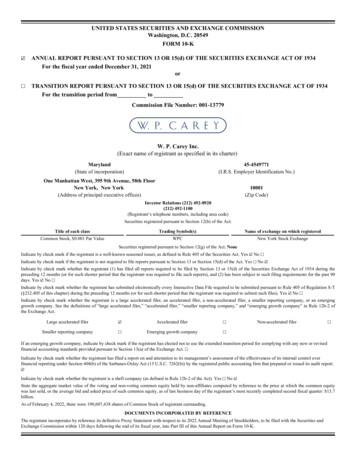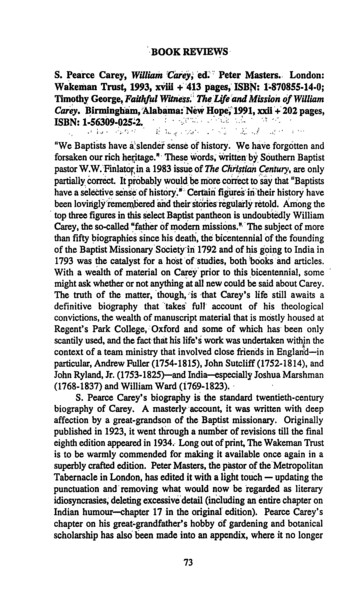
Transcription
':BOOK'REVmWSS.Pearce' Carey, Willitim'Carey; 'ed :' P ter :MaSters ,' London:Wakeman Trust, 1993, xViii 413pages '1 870855.14.0;Timothy Ge()rge,Faithjul Witness;'The'Lijeand Mission 0/ WilliamCar y ' Birmingliam, Ala,blllua:'New Hope :1991;Xxii' ' 202 pages,ISBN: 1 56309 25 2. ,',': ":;:':";'::: : :,;,,:.';':' ,.,',t ';', ':IS:oN:". " ",: .:. "f ··· .-:·;.'r!· :·' ;·"X :)l, "f :. :'.;--;},;.""" . ,.: ::':.,t.· ;/:,'", "We Baptists havea:siendersenstn)f histciry We have forgotten andforsaken our rich heQtage. Jt: These wordsi Wrltteri: by Southern Baptistpastor W.W;':FinlatOr,in a H)83 issiie.ofTizeChrlsiiQ;" f 1J'tury, are onlypartially. correct Itpiobably would iii6recorrectto'saythat "Baptists"have aseIective sense' of tiistory Ji:Certaiiifigures"lri:t1teirhistorY 'havebeen lovirtglj"remenibered:ang th ifstdriesregtiliii'l)rretold.Aniong the: top thi'ee figures in this select Baptisfpap1heon is undoubtedly WilliamCarey, the so-called i,'f ther of modem'missions. , The subject of morethailfifty iographies ·since·his death, th bicentenriial 'cif the foundingof the Baptist Missioluiry 'socieiiin1792 and ,of is'goingto India in1793 was the catalystfora ho'st'ofstUdies; both books 'and articles.With a wealth of material on CareY: priorto thisbicentennial, some '. might ask wh ther or not anything at all new could besrud about Carey.The truth of the matter, 'though, is ·thatCarey's life still awaits adefinitive biography' that':takes' 'fun' account, of 'his theologicalconvictions, the wealth of manuscript material thatis mostly housed atRegent's Park College, 'Oxford and some of which has been onlyscantily used, and the fact that his life's work was undertakeri within thecontext of a team ministry that involved close friends in England-inparticular, Andrew Fuller (1754-1815),JohD SutcUff (1752-1814), andJohn Ryland, Jr. (1753-1825)-and India--especially Joshua Marshman(1768-1837)and William Ward (i769 1823)i'"', ,S. Pearce Carey's biography is the standard, twentieth-centurybiography of Carey. A masterly'account,it was written with deepaffection by a great-grandson of the Baptist missionary. Originallypublished in 1923, it wenttllrough a number of revisions till the finaleighth edition appeared in 1934. Long out of print, The Wakeman Trustis to ,be warmly commended for making it available once again inasuperbly crafted edition. PeterMastets, the pastor of the MetropolitanTabernacle in London; hasedi@ itwitha liglittouch, updating thepunctuation and' removing what\vould ' now, be ,regarded' literaryidiosyncrasies; deletingexcessive'detail(in.cludingari entire chapter onIndian humour-chaptet17.in theoriginaf edition). Pearce Carey'schapter 'on his' great grandfather's'hobby of gardening arid botanicalscholarship has also' been made into an appendix, where it no longer",'"," " , 'as73
disturbs the flow of the story, but yet provides a valuable insight intoCarey's many-side.d character. .Yet, tbebo()k is ot without .i weakilesses,of whichilie mostglaring stems fro lIl the fact that Pean Carey was primarily abiographer with aflaIr,for.storytelling, nota histo.rian. Although he didmake good use of numerous Carey mamiscripts available to. him, he didnot hesitate to makesllght chaIlges in· his quotations from- thesemanuscripts.· As· E.A· Payne once put it:. "it would· not be right todescribe what h has done as "bowdlerisingl d never did he alterfacts. It remairis true, however, that again and. again one js not given anexact quotation"· ["tar yandhisBiographers",TheBaptistQuarteriy,. .,.I.19 (1961-1962), 8-9]. Nevertheless, Pearc Carey's account, isundoubtedlya:gr atachievement that reads well and ably fulft11s itsauthor desir.e. to provfdean gl wing portrait of Carey theman;Timothy' George,the ;D an: of Beeson: I?ivinitySchool inBirmingham, Alabama, has also given us a: highly readable account ofthe Baptist missionary. Unlike that of Pearce Carey, though,George'sbiography is well-annotated, something that is 110t only helpful forscholars but also for readers who wish to pursue further certain aspectsof Carey's life. George highlights Carey's evangelical Calvinism,which all too many biographersolCarey have ignored or only touched.on in passing., Georgealso sets Carey s life and ministry within theoverall context of, the eighteenth century and, more specifically, theEnglish Calvinisti6 Baptist community of that era. With regard to thelatter it is especially helpful to. be reminded. that Carey was a firmbeliever in what today we call "team ministry." George takes the timeto introduce us to Carey's close friends and colleagues, most of whomhave been hidden in the shadows for far too long. Yet another greatstrength of this biography is lQe inclusion of Carey's classic defence ofmissions: An Enquiry into the Obligations of Christians, to Use Meansfor {he ConversiOTiofthtHe.athen (1792); "., ' . , ., The only major weakness ofGeorge's biography is that Careyseems to be depicted as a man without faults. This was obviously notthe case, as. Carey himself well knew. He was ever conscious of "hisown shortcomings and his continuing dependence on divine mercy andforgiveness". [A.ChristopherSmith, "MythologyandMissiology:Towards a Methodology for Understanding the Serampore Trio andTheir Mission"!in,].T.K. Daniel and RE. Hedlund"eds.,Carey'sObligation and India's Renaissance (Serampore, W t Bengal: ,Councilof SeramporeCollege,' 1993),73, nA). A few other. minor inaccuraciesthat need to be n6ted:the Monday evening prayer meetings that were setapart in Calvinistic Baptist .cirCles for praying for vival fx:om the 1780son were scheduled for only one hour, not for 'iUte night" [p.49]:they 74
were inspireci .by·a.bookbYilonathan. aqwarci.s: at w s nt by .theS otsman J(}lmErsKine .to.: Jplm :Rylan ;' not:!1 John:SutcUtl". [p.50];lijenjamin··· Beddome was:notaLQndoner;as is impli d . on:. p.8.1 hepastored intheCotswolds.':·;';' i:;'!!::r:: ;':, .' . .,: .,.'; ;WhenCareyJay dying.,in, 1 4,\ ()ne:of his.·J tvisitors was aScotsman named Alexancier PJ,lff . DJ,lff; twenty::-.eight ·at e #me. wouldgo on to mellfam9UsmissiQnao'j llis O\YD.rlght.On 'the QCcasion'ofwhat po.ssiblywas his last:yisid()Carey;w aiet()ld,that Duff spentsome tim tatking.:chiefly abciutCl,lr y1 s :achieyementstill at length thedying man whispered"Pray."· Duff knelt and prayed. and then saidgood-bye. As he was leaving the room.h thoughthe heard Carey'sfeeble Yoicecallirig his name.: !lMr;: Duff.l\IIr.:pJ,lffo:Ple e.one morething hefpre you go. . '.He stepped back accordingly;. and this.is wh t heheard. spoken with a gracious solemnity:· !IMr;DUff;you have beenspeaking about Dr. Carey;Dr. Carey;whenl am g(me. say nothingabout .Dr.Carey. speak about· Dr. Carey' s Saviouri ' .This story is awell-known one and gnethat both of ourbiograpQersrelate (Carey.William Carey. p.374; George.William Carey, p.2).' Ii is obvious fromthis story that Carey would not have been pleased with either of thesebiographies-:-,-nor with this review for that matter I Yet. as Ernest A.Payne observed over thirty years ago: "ever since his death people havebeen talking not only about Dr. Carey's Saviour. but about Dr. Carey.for his story is not one that .can be forgotten. 11 ["Carey and hisBiographers". p.12]. And to hear the details of that story. both of thesebiographies are an excellent place to begin.Michael A.G. I - I a y k i n . . · ·Heritage Baptist College and Theological Seminary:.London. Ontario.,Sunil Kumar Cbatterjee, Felix Carey (A Tiger Tamed). Hoogbly,West Bengal: Sunill{umar Chatterjee, 1991, 122 pages. Availablefrom: Mr. Sunil KumarChatterjee, 6Cbatterjee . para lane,Sheoraphuli712223 Hooghly, ·West Bengal, India.\ ."Although there have been more than fIfty biographies ofWilliam Careysince his death in 1834. his co workershave been deft in relativeobscurity. This isalso:the case for his sons. a number of whom followedin their father's footsteps. This bookisa highly infcirmlitivebiographyof the eldest of his sons. FeJix Carey (1786':'1822). .Though there havebeen articles on Felix Carey's life/this appears to be the fIrst booklength study of a man who was. during the .course of,his short life. a75
·.linguist, physician,missibnary, educator, and Burmese ambassador. Itwas of Felix's role as thcrlattet his father made the'famousreinark toJohn Ryland, Jr. that his son had "shrivelled from a missionary into anambassador" [p.114]. His personaIlife contained a number of serioussetbacks and tragedies; among them the deaths of three wives [there isa particularly movingac.c:ount of the death of his second wife and twochildren by 'drowiling in August 1814. on p.SS-S8]. Of specialsignificance was his extensive knowledge of Bengali, which enabledhim to makearilimbetofimportaritcontributions to the literaryrenaissance of that language [full particulm ·of these contributions aregiven on p.81-89,.110-113];.Chatterjee has drawn on a wide variety of sources, both primaryand secondary, in' this. biography, and made good use oh number ofFelix's letternhat are still in manuscript and unpublished . A helpful listof these letters appears as an appendix·[p.10l-1091. The only 'drawbackof the book are the numerous typographical misprints and errors, forwhich Chatterjeeapologizesin his "Acknowledg mentsin Apart fromthese, though; this biography is an excellerit introduction to a man whocan be rightly described as "atigei' tamed" and Who has been wronglyoverlooked because of the great shadow cast by his famous father;., . ., ",.',':;:'IMichael A.G;Haykiil,;;,': .'"Heritage Baptist College and Theological Seminary,London, Ontario.Richard Coggins, Introducing the Old Testament. OXford: OXfordUniversity Press, 1990,165 pages.This volume by Richard Coggins is part of the Oxford Bible Serieswhich is designed to provide an overview of Bible introduction andinterpretation. Coggins'voltiIilefits well with the purpose of the seriesby presenting to'· the: reader, ili1;overview of the' form'of 'the OldTestament : texts; a history Of their· transmission, arid the' type ofscholarly research which has been addressed to the text. Cogginsprovides an overview of the world of the Old Testament (historical,literary; .and ideologieat) Withollfgettirig bogged down in the details ofthe history formation ofany one biblical book: Therefore, chaptersare inCluded on the problems of the historicity of the Old Testament, thesocial niake-upof rsrael;,thereligfon ofIsrael, .and the problems raisedby contemporary perceptloris'pfthese:issues;\ . i' ,': ., In the iniroduc:tloii to the bobk;-CoggiilS expresses his gratittide touniversitysiudents who have; over.thcyears; prompted his thinking andor,!76
his hope t4atfutures4Iden WU1 find ,the'90ok a help in their study. In. . my opirrlon;c:oggiiis; h6p iln) ft.tlfill ,but sw shcaD IUSO serve'. as.a mai'lcer bywhicq t ideiitli)/.the. aU9it nc 'for which 'this book was.written; .It 'is'not .a 1l00kwhich canbe:'CaSily, absorbed'by' those not. accustomed :to e typ 'on qQiij'founCi:in'aulliver iij setting. '. ,:. . liis obVious·tli tCogguis iS'a'bapable Qld:Testmrierit 'scholar. His ontiibuti9iiSto the ti ld tarigeov fa.·riiUIlber'pf years'-'andivariety of.' subjeCtS. "This pr settfVolumetouclies' po niosrofthe uirent issuesfacing Old . Tes ociologyian opologYfand'rie\\fIiierill'fciiti iilIii);,::rrt is reSpect, the.' only disappointing feature thes anfsiieof'the: i1 liography whichappqllrs 'at'tlieend of the;.::" i::; ' :.;/iI;':;' :fC .::'·?; f,' i'i'.' . To'ilhistrate the tYpe ofissues'addressedbyt:bggi sl would liketo take a closer look at' the'questi()nwlii911'fq#Ds'th ;title' of the lastchapter in the b'ook, .'lIs .' '. Theolcigypbssible1n;: t\Fftrstglance thequestion might appear absurd. AftCiall,iso't the Bible'a religious bookproperly' opened . by·theo ogical investlgatioq'l.:,As·· Cogginsdemonstrates,:.the issileis (not: that' sim:ple ::, . Earlier ,ill, this .century,theologiahsdevel6ped theirunder tahding. of the Oid;Tes ent briderthe generalnibi'icof a theme such'as the mighty·'a.cts of God, or the 'history of redemption. This approach'haS byiand large fallen intodisfavour, for it has become plainlthatthe diverse nature of the OldTestwnent library does not lend itSelf t,oa.single,AoJ;llIIlon 'theme as wasadvocated by earlier'scholars. Coggiris pre ents alternative outlinefor theology which includesfour,asser:tions which maintains are'. authentically 'a concern of 6iblical'JDate'rl81and"of"alid interest: tothe .' reader today. · . 'These'ifout:'tlieologicali,p()intSare: :1):;The: Old'. Testament statements'IaboutiQod anQi liisnaUire;i2),' the concernJor:. social, al es;3) religiouS'critique;(4):ihe·t\iiiction:of!doubt. .In. thedevelopmenf of these four'pointS, Coggins answets'affii:m.advely.thequestion:that mtroducesliisfinal·chapter{yes :a' theology is possible .' :. ':!There are; ()thertwriter:s h()wevei.:wn do 110t;sh ehis opinion.,John Collinshas recently addressed thequeStiQn'ofOll .coni:patibility of.' the historical cntical approliCh.and 'biblical: ,iIu;ology"W!IsA Critical, Biblical TheologyPossible,?Hn; The HebfewiBib.le (wHts;Interpreters;isbook.'a4the' s,WilliaDiPropp,Barucb'Helper.JkDa:vidjF:r.e an(\Vinona Lake:theEisenbrauns, 1990), 1 17]. His concljJsionis thathistorical,criticalapproach;'whicl1 iserves asibemetil()dology:'for.:,bi lic :studies, may . itself be inc'ompatitire;with a confessioJlaltheoiogy'that is committed. to speciflc'doctqne theib isoffirlth· [iQid:;'p.14] o('1;hehistoricalunderstood 1 yCollinS' isb edupon .aset ofcrlticalapproachprinCiplesfor historii!aI inquiry formulated by Ernst Troeltsch in 1898.These principles : 1) The principle ,of criticism .which asserts· thatj '77
since any conclusion is subject to revision, historical inquiry can neverattaip. absolute certainty, only a l velofprobability; 2) the principle ofanafbgy, meaning that historical Jmowl dge is 'possible because allevents are similar in prlnciple;'3) the principle of correla.tion whichstates that all phenomena in history are inter-related and no eVent can beisolated from a sequence ofcause and effect. These presuppositionalguidelines are for CollinsincOInpatible with assertions about thetranscendent, casting great doubt on thepro!P'am of biblical theology astraditionallyformulated". .,.'.For Collins, t O options.present themselves. He may follow themore radicaliInpiications ()f the historical-critical.niethod in it fashionclearly seen in recent socioiogical' treatments of the biblical text.Norman Gottwalds's conclusion that the .God oflsrael waS the symbolfor the social ideal ()f ly tribal Isx:ael illay serve;' a casein point [TheTribes ofYahweh (Maryknoll: Orbis;:t9.79)l.·Or·Collinsmay follow apath which does not,lead to such complete reducdonist conclusions andrecognize that the. biblical, text does:; contiiin . proposals . aboutmetaphysical trutlt ,The difficulty with this app oach is, according toCollins,. that "we lack'any .acceptable' yardstic by' which to· assessmetaphysical truth" .["IsA Critical Biblical:Theology Possible?", p.14].Herein. lies the .rub. nEither·.one mu'st accept the naturalism of.Troeitsch, of()riemustbeopel1 totranscendencelsee PeierStuhlmacher,Historical CrlticismandTheologicaUhterpretation a/Scripture, trans.Roy Harrisville'(Philadelphia:Fortress, 1977)]. :·Orican.the two be heldin tenSi(m?:i A.t leastinta'iqualified fasliion,·the·answerto this'lastquestionmqst be,atentadve yes,:aseviden:ced by: Coggins!;m aningfulstatement :about ihe.naiure;()f.God.i'Ibe'tension'can bemaintaiJied, as.' Joseph Fitzmye has. stated;Zby Jre :ognizlng' :the;pi'esuppositions withwhich the;schollir.titlilizesjtbe;.historical criticaLniethod;[':Historical . ". Criticism:;;ItS"jltoie,;"in,JH iical)nterpretati()n :and.'C;hu chLife",.11ieological:Studies;,S07 J989)' : 4 2S91.:!FitzmyeJ:' ; the :bbc,kbeirig: crincallyinterpreted l:ontaills' . God's Word :setJorth:Jifhuman'\words'.oflol1g.,ago, that if has been .· composeduit er)he.'giiidance'oftheSpiribthat it is partof restrictedcollection ofsaered,.lluthoritative Wtitingf[partof a anon];, that it has· been. given by; God to His pebpleJortheirooificatiol1:and;salvation"[ibi4., p.Z54-:2SS].'.,;",;' ,. '.::' :.It is thi c6n ern with the manner of approach .by which a scholarcomes to the biblical text.thatresides.atthe . coreof Coggins' book andtha , mak:esiit(a; aluable tool" for,: understanding: , the . nature. of· contemporary bi1?lical,sch6larshipaIld introducing th Old Testament.Terry Giles;.1
Gannon University,Erie, Pennsylvania.".Stephen R. Covey, etaL, First Things First. NewYork:SimonandSchuster, 1994,360 pages.Steven R. Covey's First Things First is a second aildmost recentattempt tobtiHd on his I! Seven Habitsi!':Putting;flrst things'first (habitnumber three) expresses ilnattempt to move beyond first, secondj andthird generation time management, which according to the author tendtopri()dtize theurgeni.coveytakesa"dlffererittapk and moves to aprinciples drlven,Vision-activ Schectuling.(fourtIlgen ration); .It isamove away from the cloCk ' and toward the , lcompass; The authors· insist that doing more tllingsfaSter is ilosubstitUte ,f ?r doing the rightthi gs.Prioritiesaregciod; principiesare.better ;'i;, .c;. ,.!,.:;.,;:, :.: . '. :First ThfngsFirst not,onlycoIltaiDs \Jasive( time:Wllilagementtheol}'that.goesbeyQndtlle'!'quic J x'! m n@ty ;b t,tak , cin.th Jormof a workbook aswel. ··It;eilables:;tbe;·Ie.ader!to work]hrough thematerial and aetually'tise tile bopk .In.pres,enting and 'developing theconcept of an Ilimportance paradigm; 'the' authormake ·use.of relevantiIlu trations, stories" quicky quiz.zes;:,self-::tests'aJld sarnple:,schedules . .The autll0rsassurne -;from theheginning:that very p.nehas theneed to l 'liye,'love, learn; aIld'leave: :.}egacy;JI: :From thatassu:m:ptionthey demonstrate how fourth.,.ge erap6n time maJiagemeni takes intoaccount these needs, helplfto:buildiDJler strerigtlJ makesuse cihisionand mission;' ilild directs one 'into a true .!ltoJe,sYnergy ,tllat enables an. individual t() be entrepreneurial andpro;active" inigiving'leadership tohislher life. t' : .;; :. , ' ; :;'. y, . :' cl,!: '' .'\ The book aIso9pnulins ausable'supplement to the main text in thethree appendicesJAppendbfA ;gives sufficlent'llm,terihlf()I' a "missionstatementJl .w()i'ksho .,; Appendix :B':contains .an'·' xcellent review andevaluation of time management literature; and Appendix C' gives aquick overview of the nature and types of.' wisdomliterature:"Finally,a quickrefereilce guide for accessmg m terial;;issupplied to thereader/user in'the'forJnofan:index/"'lU,. ':H :l '.:,;,:;" :'. '.; The' book on pririciple;:drlveri' time mami.geinent is' an effectivereminder that there is allbestJl way to handle thecomplete'demands on .·one'!j·time;'!t'forms the firialleg ofthe "CoveY·triologyl! : The 7 Habits· of Highly EffeCtive People PririCipl CeriieredLeadership; First ThingsFirs all.;. of. '\ tiich' are; equally ::!'coiripatibte\vith: the Christian'cbnsCience; )niheopilliQNOf.this'revi# r::'first :Things First is anifnpcirtant'book' WhichhClp ;the; lIser .to a 'balanced 'life' ofwill'79
productivity and personal development.J. Cianca,Heritage Baptist College,London, Ontario. .Lyle W. Dorsett, iJillySur:ulay and the Redemption of Ur1!an America.GrandRapids: Wm B . EerdmansPub)., Co., 19!)1, 212 pages. .,;Billy su .d"dJk ' demptionof Urban Anterlca is a short biographyofa very important religtousfigute of the nineteellthcentury;. Lyle W.Dorsett,' professor f histOry and urban stUdies. atWheaton College, hasattempted a studY' cif the life'ofWilliam A:(Billy) Sunday (1862-1935)and his family,'bui hasfail@ to.view him as one of the more complexfigures in Anierican;·church:rhistory. ;,;Dorsettviews Sunday in asympathetic tone. He notesth.e fariiily difficultleS;the struggles, and thebackground of one of America's best-known evangelists. We see theflaws, insecurities; and his agonies; yetthe author fails to analyze themotives behind the 'preacher' s efforls or his .historical context. 'The evangelist was the most significantof,tabernacle revivalists.He preached to tens of millions of Americans from· the end of hisbaseball'career ill 190() to hisfirtal sermon on the evening of Sunday,.October 27;'1935,WhjleStlnday implored lost souls to.repentof theirsins, he often failed :tcftealize their \voddlyneeds; . He vehementlydenounced. demob nimjdancing, .artd . adultery; ··while vigorouslyexhortingthe.faith!ul\ (ilndnot-sofaithful)to empty their pockets andpurses for the fuithetan6e, ofthe gospet' and Billy Sunday. The .authornotes the fulancilri benefitS that SUndaY,ai1dl1is fatnily derived from hisrevivals' andwrititigs;- llt'passes over .them. tQoeasily. and makes littleallempt loquestion .tbe true.sincerity' QC the:onetime baseball player.AlthoughSundaYiappeare'(t,q. b mptived:by';adeep.concerp,for thesouls of hisfeJlow htlriianbeings;: ne mtistquestion the lavish lifestyle,privilege.an.d.sociIllJ f ; a eSundaysgre to, expect. . . . l' .:., .'The failure of.·BillY and'.· NeJl . undaYr to . fmse,.;chilctkn .thatfollowed inthdr.religi6us fQQtsteps calls, into question the examples thatthey bequ thed tQ* ir offspring; Asidetheir daughter Helen,. histhree sons;livedaJife.,that.yo{as the: antithesis of their parents' beliefs.Divorce, alc9hoiism,,:fii'l.an ialproble ; .wretchedness, .' and scandalbeset the childr nofth ,evangelist, .but .Dorsett fails to adeq\latelyanalyze eithet the psych6logicalqr sociological reasons. The authormentions "the lapses of go Xl judgment" and theiJ.' talk of doing "God'sfrom80
wode" amltheir deSrreto be:in (lOod's will." Dotsettwso n tes that theSundays had straye4beyond scriptural guidelines for .discipleship, yet. he fails to adequately grapple with the worldly desires and egotisticalnatureofa simple DiflD.: ",;ij ' : '",,',.,:. . 'This book is too short; In writing.a biography, one must closelyexamine the compl tesource material and spend considerable time onreflecting about the · ersonage involved: The author has not adequatelyexhausted or carefuny examined the source material. It would also behelpful to have footnotes so that the accuracy of the book's contentscould be ascertained.Sunday was a brilliant, yet simple man, who Qnce said to his wife,"Ma, where did I' go wrong?" I thought we ljeard God's call toevangelism. But look at our boys! Where did I go wrong?"BiIIySunday knew where he had gone wrong. But the author fails to note thereasons for Billy Sunday's successes and failures.Daniel Strong,.Unionville, Ontario.Brian Edwards, Is Hell For Ever?Publications, 1992, 16 pages.Bromley, Kent: Day OneThis little booklet discusses the difficult question of hell and does so ina clear, forthright manner, In conversation with a young Christian,Edwards .tackles head onthe discomfoItClu:jstians feel with thissubject His approach is not designed to, make us feel better, but to makeus think better, He advises us to start with God's evelation rather thanour own opinions. He thengoes.on to .show that e reality of hell isclearly taught in Scripture and rev.iew key passages', As expected, thetwelve-page booklet does not allow a full trelltment, .but it is a goodplace to begin. ',', ., .Murray Pipher, .Markham,On o"Brian Edwards, ft1uzt'.so Special:4bo tSu1}dayt.BJ;omIey, Kent: DayOne Publications,; 1992, 16 pages. ,.:,.' . . . . .This little' booklet ;is a defenseof thei,traditiOpal;.Christian· Sunday,.' written in dialogue format Edwatds .argui s thatthe seventh ,day isspecial because of the patterriof cn a on(God. . . did not need. six days, he 81
could have created the world instantly), the commandment starting· with"Remember" (Exodus 20:8, referring back to the creation pattern) andthe endorsement· of the .Sabbath . by Christ for our benefit. Thesebenefits are then described as: rest for the body, remembrance of thecreator, worship forthe soul,and the hope of heaven. All in all, it is aninteresting little primer Though somewhat simplified, it takes Scriptureseriously and presents the key arguments clearly and logically .Murray Pipher;;· .Markham, Ontario . ,. ,.:q." .Jonathan" Edwards, Sinnersln the.liands; of. an Angry God.Phillipsburg; New Jersey: P & R PubliShing, 1992, 32 pages.··.',"" . " " ".On July 8, 1741 arthe Congregationalist chUrch ill Enfield, Connecticut,Jonathan Edwards(1703-1758) delivered whatis probably the mostfamous sermon in American history: "sinners in the Hands of an AngryGod." It was the time of the First Great Awakening in America, whenthe Spirit of God was bringing thousands into the Kingdom of God.The Enfield church, though, was oblivious to the revival, and themembers generally had little "or no concern for spiritual things. But theresponse that Sunday was dramatic - before Edwards was finishedpreaching there "was a great moaning and crying out" as people criedout for mercy and what they were to do to be saved. Though not anoverly emotional discourse,Edwards, like other great preachers of thatrevival, minced no words when it came to sin. " 'Every "unconvertedman properly belongs to hell," he told the congregation that m()rning[p.14]. In very pointed language he urged upon his hearers the truth thatthose who have no interest in Jesus, the only mediator between God andfallen humanity, have" absolutely "nothing to lay hold to savethemselves" and "nothing to keep off the flames of wrath" fp.231. Allwho have "never passed under a great change of heart, by the mightypower of the Spirit·of God" are tinder God's wrath -'- they. "are in thehands of an angry God" [p.22].1bis truth about unregenerate men andwomen - never appreciated by them; only acknowledged under theSpirit's conviction - has always been prominent at those times whenthe kingdom Of God has'tnade great advances. One need not guess whatEdwards would have thought about those in our day who think that the.unconverted can be won to Christ by glossing over sin and saying littleor nothing about it soasilotto scareaws.y sensitive seekers I A veryhelpful introduction by John D; Currid, who teaches at Grove CityCollege, sets the sermon in its· historical context.82
MichaeIAG.Haykinj', , '"Heritage Baptist College andThcologicalSemlniu"y,London, Ontario.",,John M. Frame, Evangelkt4'Reunion:Denoininationsand the Bodyo/Christ. Grand Rapids: Baker Book HOuSe :'l991,185 pages.Rarely do I encounter a book that I simply cannot put dowr;l, but this isone. Fortunately, I sat down to read it when every other member of myfamily was away for the day,aild I found myself caught up in anunforgettable literary adventure. John Frame is a professor ofapologetics and systematic theology at Westminster TheologicalSemimiry-West, and given his involvementin a separatist Presbyterianmovement, one would 'hardly expect from him a 'passionate plea fororganic (re)union of evangelical churches; "As a'result, this bookshatters several stereotypes. ': Frame argues that New Testament teaching on the,nature of thechurch indicates that Christ established one church,' and this unity is tobe manifested both'spiritually and structurally." If this is true, then'denominations (which refuse to be' structurally united with otherdenominations) must be rooted in error and sin. While, this may sound'like just another doctrinally indifferent,' ecumenical plea; that is far fromtrue. Friune ispleadjng fot, evangelical'reunidn,:'not reunion of everytype. In fact, he ar ues that an important step toward reunion is theactive discipline oftbeological'liberals in all denominations, ,leading toeither their repentaJice or their expulsion; .! :;;c''; , ' :,' :.' 'Frame is idealistic; but not naively idealistic. He believes thatChrist will one day reunite his church, but he knows that such an eventis not visible on the horizon. What he does assert is that if visible unityis the desire of the Lord, then we should be actively doing whatever wecan to effect reunion or take steps in that direction.' ,Most of ihe book isdevoted to theory, with olliers.leftto dealwithibe mechanics, but thebook is not impractical. The author recogriizes that ifhis argument isto be at l compelling, then he will have to answer some obviousquestions;, For example, he suggestS some ways in! Which Baptists andpaedobaptistsJnight work together; iJl' a unlted'chUrch}"The, finalchapter;,/lWhat' Do We Do Now?"; lists 34 'practical steps t6, takeimmediately: Numberi9is:,."Find three gQod'jokes about your owndenomination or tradition and share them with your':fellow members."This is no cJrYtheology!,,", "" It seems peneetlyclear from ourLord's prayc;iin JOM 17 that hedesires a unity among his' people which iS'visible l()the world as a83
whole, and most of us have at some tim met 'unbelievers who werescandalized by th ; di*isiollsofChristendom ,Therefore, withitsfaults, this bookisapi asure to read It is Writte with passion, but withclarity, charity,andwit.Framerevealsan obvious love for the churchand a willingness, to get involved'in lhelifeofthe church, even when. that is painf\11." . pthiS}:espe 4 h is., a mc; deltheologian, who sunwillingto do his workapai'Mr ebeliC?ying,community . ". ,. .Frame's basic point that there ought to be a visible unity of thechurch uniy s ,os.e«?p:1S;sqlJ y o nded in the N. ,w'Testathent pictureof the chur h "What.i,sle sl?ie i'iisthealnourit of organizational unitywhich this demands.; At the very lellSt, Frame has to admit that the NewTestament does notSive any explicit organizational structure. However," he is right'to remi!ldJls,that theJ)iblical concemfor the interoependenceof all themembers'.of the Body:pf, Christforbids:the kind ofextremeindependency Which is so common among Baptists.I have the
(1768-1837)and William Ward (i769 1823)i' "', , S. Pearce Carey's biography is the standard, twentieth-century biography of Carey. A masterly'account,it was written with deep affection by a great-grandson of the Baptist missionary. Originally published in 1923, it wenttllrough a number of revisions till the final
![Welcome [carey.jhu.edu]](/img/15/gmba-welcome-packet-class-2020.jpg)
